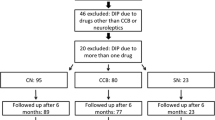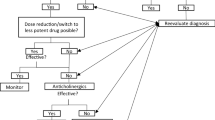Opinion statement
Drug-induced parkinsonism (DIP) is condition that mimics Parkinson’s disease. Characterized mainly by rigidity and bradykinesia, it has less prominent tremor and gait instability. DIP is generally caused by lipophilic drugs that “block” dopamine D2 receptors in the brain, although presynaptic dopamine depletion, false transmitters, mitochondrial respiratory chain dysfunction, and overactivity in the γ-aminobutyric acid (GABA)ergic system or cholinomimetic action have also been postulated as possible mechanisms. The onset of DIP is acute to subacute. It is more common in women and has a bimodal age distribution. Other diseases that can resemble DIP include neuropsychiatric conditions (eg, depression, negative symptoms of schizophrenia) and Wilson’s disease.
Physicians may be able to prevent DIP by prescribing neuroleptic agents appropriately and with caution. The risk of DIP is presumably lower with the use of “atypical” antipsychotic agents but it is not eliminated, especially in those most vulnerable to parkinsonism (eg, the elderly or cognitively impaired). The best treatment is discontinuation of the provoking medication. Prospective studies are needed to further define the mechanism of DIP, identify individual susceptibility, determine the impact of atypical antipsychotic agents, and develop further treatment options for those unable to stop the offending agent.
Similar content being viewed by others
References and Recommended Reading
Halliday J, Farrington S, Macdonald S, et al.: Nithsdale Schizophrenia Surveys 23: movement disorders. 20-year review. Br J Psychiatry 2002, 181:422–427.
Ayd FJ Jr: A survey of drug-induced extrapyramidal reactions. JAMA 1961, 175:1054–1060.
Ebadi M, Srinivasan SK: Pathogenesis, prevention, and treatment of neuroleptic-induced movement disorders. Pharmacol Rev 1995, 47:575–604.
Steck H: [Extrapyramidal and diencephalic syndrome in the course of largactil and serpasil treatments.] [article in French]. Ann Med Psychol (Paris) 1954, 112:737–744.
Ganzini L, Heintz R, Hoffman WF, et al.: Acute extrapyramidal syndromes in neuroleptic-treated elders: a pilot study. J Geriatr Psychiatry Neurol 1991, 4:222–225.
Modestin J, Stephan PL, Erni T, Umari T: Prevalence of extrapyramidal syndromes in psychiatric inpatients and the relationship of clozapine treatment to tardive dyskinesia. Schizophr Res 2000, 42:223–230.
Hobson P, Gallacher J, Meara J: Cross-sectional survey of Parkinson’s disease and parkinsonism in a rural area of the United Kingdom. Mov Disord 2005, 20:995–998.
de Rijk MC, Tzourio C, Breteler MM, et al.: Prevalence of parkinsonism and Parkinson’s disease in Europe: the EUROPARKINSON Collaborative Study. European Community Concerted Action on the Epidemiology of Parkinson’s disease. J Neurol Neurosurg Psychiatry 1997, 62:10–15.
Esper CD, Factor SA: Failure of recognition of drug-induced parkinsonism in the elderly. Mov Disord 2008, 23:401–404.
McGeer PL, McGeer EG, Hattori T: Dopamine-acetylcholine-GABA neuronal linkages in the extrapyramidal and limbic systems. Adv Biochem Psychopharmacol 1977, 16:397–402.
Keepers GA, Clappison VJ, Casey DE: Initial anticholinergic prophylaxis for neuroleptic-induced extrapyramidal syndromes. Arch Gen Psychiatry 1983, 40:1113–1117.
Moleman P, Janzen G, von Bargen BA, et al.: Relationship between age and incidence of parkinsonism in psychiatric patients treated with haloperidol. Am J Psychiatry 1986, 143:232–234.
Montastruc JL, Llau ME, Rascol O, Senard JM: Drug-induced parkinsonism: a review. Fundam Clin Pharmacol 1994, 8:293–306.
Gordon JH, Gorski RA, Borison RL, Diamond BI: Postsynaptic efficacy of dopamine: possible suppression by estrogen. Pharmacol Biochem Behav 1980, 12:515–518.
Quinn N: Parkinsonism—recognition and differential diagnosis. BMJ 1995, 310:447–452.
Hardie RJ, Lees AJ: Neuroleptic-induced Parkinson’s syndrome: clinical features and results of treatment with levodopa. J Neurol Neurosurg Psychiatry 1988, 51:850–854.
Goetz CG: Drug-induced Parkinsonism and idiopathic Parkinson’s disease. Arch Neurol 1983, 40:325–326.
Alvarez MV, Evidente VG: Understanding drug-induced parkinsonism: separating pearls from oy-sters. Neurology 2008, 70:e32–e34.
Hassin-Baer S, Sirota P, Korczyn AD, et al.: Clinical characteristics of neuroleptic-induced parkinsonism. J Neural Transm 2001, 108:1299–1308.
Booij J, Speelman JD, Horstink MW, Wolters EC: The clinical benefit of imaging striatal dopamine transporters with [123I]FP-CIT SPET in differentiating patients with presynaptic parkinsonism from those with other forms of parkinsonism. Eur J Nucl Med 2001, 28:266–272.
Merle U, Schaefer M, Ferenci P, Stremmel W: Clinical presentation, diagnosis and long-term outcome of Wilson’s disease: a cohort study. Gut 2007, 56:115–120.
Rajput AH, Uitti RJ, Stern W, et al.: Geography, drinking water chemistry, pesticides and herbicides and the etiology of Parkinson’s disease. Can J Neurol Sci 1987, 14(3 Suppl):414–418.
Wilson JA, MacLennan WJ: Review: drug-induced parkinsonism in elderly patients. Age Ageing 1989, 18:208–210.
Nyberg S, Olsson H, Nilsson U, Maehlum E, et al.: Low striatal and extra-striatal D2 receptor occupancy during treatment with the atypical antipsychotic sertindole. Psychopharmacology (Berl) 2002, 162:37–41.
Nordstrom AL, Farde L, Halldin C: Time course of D2-dopamine receptor occupancy examined by PET after single oral doses of haloperidol. Psychopharmacology (Berl) 1992, 106:433–438.
Lieberman JA, Tollefson G, Tohen M, et al.: Comparative efficacy and safety of atypical and conventional antipsychotic drugs in first-episode psychosis: a randomized, double-blind trial of olanzapine versus haloperidol. Am J Psychiatry 2003, 160:1396–1404.
Kapur S, McClelland RA, VanderSpek SC, et al.: Increasing D2 affinity results in the loss of clozapine’s atypical antipsychotic action. Neuroreport 2002, 13:831–835.
Tarsy D, Baldessarini RJ, Tarazi FI: Effects of newer antipsychotics on extrapyramidal function. CNS Drugs 2002, 16:23–45.
Casey DE: Pathophysiology of antipsychotic drug-induced movement disorders. J Clin Psychiatry 2004, 65(Suppl 9):25–28.
Stahl SM: “Hit-and-run” actions at dopamine receptors, part 2: illustrating fast dissociation from dopamine receptors that typifies atypical antipsychotics. J Clin Psychiatry 2001, 62:747–748.
Arnt J, Skarsfeldt T: Do novel antipsychotics have similar pharmacological characteristics? A review of the evidence. Neuropsychopharmacology 1998, 18:63–101.
Rochon PA, Stukel TA, Sykora K, et al.: Atypical antipsychotics and parkinsonism. Arch Intern Med 2005, 165:1882–1888.
Tarsy D: Neuroleptic-induced extrapyramidal reactions: classification, description, and diagnosis. Clin Neuropharmacol 1983, 6(Suppl 1):S9–S26.
Molho ES, Factor SA: Worsening of motor features of parkinsonism with olanzapine. Mov Disord 1999, 14:1014–1016.
Gwinn KA, Caviness JN: Risperidone-induced tardive dyskinesia and parkinsonism. Mov Disord 1997, 12:119–121.
Fernandez HH, Trieschmann ME, Friedman JH: Aripiprazole for drug-induced psychosis in Parkinson disease: preliminary experience. Clin Neuropharmacol 2004, 27:4–5.
Fernandez HH, Trieschmann ME, Burke MA, et al.: Long-term outcome of quetiapine use for psychosis among parkinsonian patients. Mov Disord 2003, 18:510–514.
Connemann BJ, Schonfeldt-Lecuona C: Ziprasidone in Parkinson’s disease psychosis. Can J Psychiatry 2004, 49:73.
Casey DE: Implications of the CATIE trial on treatment: extrapyramidal symptoms. CNS Spectr 2006, 11(7 Suppl 7):25–31.
Factor SA, Friedman JH, Lannon MC, et al.: Clozapine for the treatment of drug-induced psychosis in Parkinson’s disease: results of the 12 week open label extension in the PSYCLOPS trial. Mov Disord 2001, 16:135–139.
Owens DGC: A Guide to the Extrapyramidal Side-Effects of Antipsychotic Drugs. Cambridge: Cambridge University Press; 1999.
Gerlach J, Korsgaard S, Clemmesen P, et al.: The St. Hans Rating Scale for extrapyramidal syndromes: reliability and validity. Acta Psychiatr Scand 1993, 87:244–252.
Kim JH, Jung HY, Kang UG, et al.: Metric characteristics of the drug-induced extrapyramidal symptoms scale (DIEPSS): a practical combined rating scale for drug-induced movement disorders. Mov Disord 2002, 17:1354–1359.
Inada T, Beasley CM Jr, Tanaka Y, Walker DJ: Extrapyramidal symptom profiles assessed with the Drug-Induced Extrapyramidal Symptom Scale: comparison with Western scales in the clinical double-blind studies of schizophrenic patients treated with either olanzapine or haloperidol. Int Clin Psychopharmacol 2003, 18:39–48.
Chouinard G, Margolese HC: Manual for the Extrapyramidal Symptom Rating Scale (ESRS). Schizophr Res 2005, 76:247–265.
Loonen AJ, Doorschot CH, van Hemert DA, et al.: The schedule for the assessment of drug-induced movement disorders (SADIMoD): inter-rater reliability and construct validity. Int J Neuropsychopharmacol 2001, 4:347–360.
Goetz CG, Fahn S, Martinez-Martin P, et al.: Movement Disorder Society-sponsored revision of the Unified Parkinson’s Disease Rating Scale (MDS-UPDRS): process, format, and clinimetric testing plan. Mov Disord 2007, 22:41–47.
Albanese A, Colosimo C, Bentivoglio AR, Bergonzi P: Unsuspected, surreptitious drug-induced parkinsonism. Neurology 1992, 42:459.
Holloman LC, Marder SR: Management of acute extrapyramidal effects induced by antipsychotic drugs. Am J Health Syst Pharm 1997, 54:2461–2477.
Wirshing WC: Movement disorders associated with neuroleptic treatment. J Clin Psychiatry 2001, 62(Suppl 21):15–18.
Fann WE, Lake CR: Amantadine versus trihexyphenidyl in the treatment of neuroleptic-induced parkinsonism. Am J Psychiatry 1976, 133:940–943.
Ing TS, Daugirdas JT, Soung LS, et al.: Toxic effects of amantadine in patients with renal failure. Can Med Assoc J 1979, 120:695–698.
Jansen EN: Clozapine in the treatment of tremor in Parkinson’s disease. Acta Neurol Scand 1994, 89:262–265.
Bonuccelli U, Ceravolo R, Salvetti S, et al.: Clozapine in Parkinson’s disease tremor. Effects of acute and chronic administration. Neurology 1997, 49:1587–1590.
Hornykiewicz O: Parkinsonism induced by dopaminergic antagonists. Adv Neurol 1975, 9:155–164.
Garcia-Ruiz PJ, Javier Jimenez-Jimenez F, Garcia de Yebenes J: Calcium channel blocker-induced parkinsonism: clinical features and comparisons with Parkinson’s disease. Parkinsonism Relat Disord 1998. 4:211–214.
Wooten GF, Currie LJ, Bovbjerg VE, et al.: Are men at greater risk for Parkinson’s disease than women? J Neurol Neurosurg Psychiatry 2004, 75:637–639.
Claxton KL, Chen JJ, Swope DM: Drug-induced movement disorders. J Pharm Pract 2007, 20:415–429.
Van Gerpen JA: Drug-induced parkinsonism. Neurologist 2002, 8:363–370.
Rodnitzky RL: Drug-induced movement disorders in children and adolescents. Expert Opin Drug Saf 2005, 4:91–102.
Author information
Authors and Affiliations
Corresponding author
Rights and permissions
About this article
Cite this article
Susatia, F., Fernandez, H.H. Drug-induced parkinsonism. Curr Treat Options Neurol 11, 162–169 (2009). https://doi.org/10.1007/s11940-009-0019-3
Published:
Issue Date:
DOI: https://doi.org/10.1007/s11940-009-0019-3




